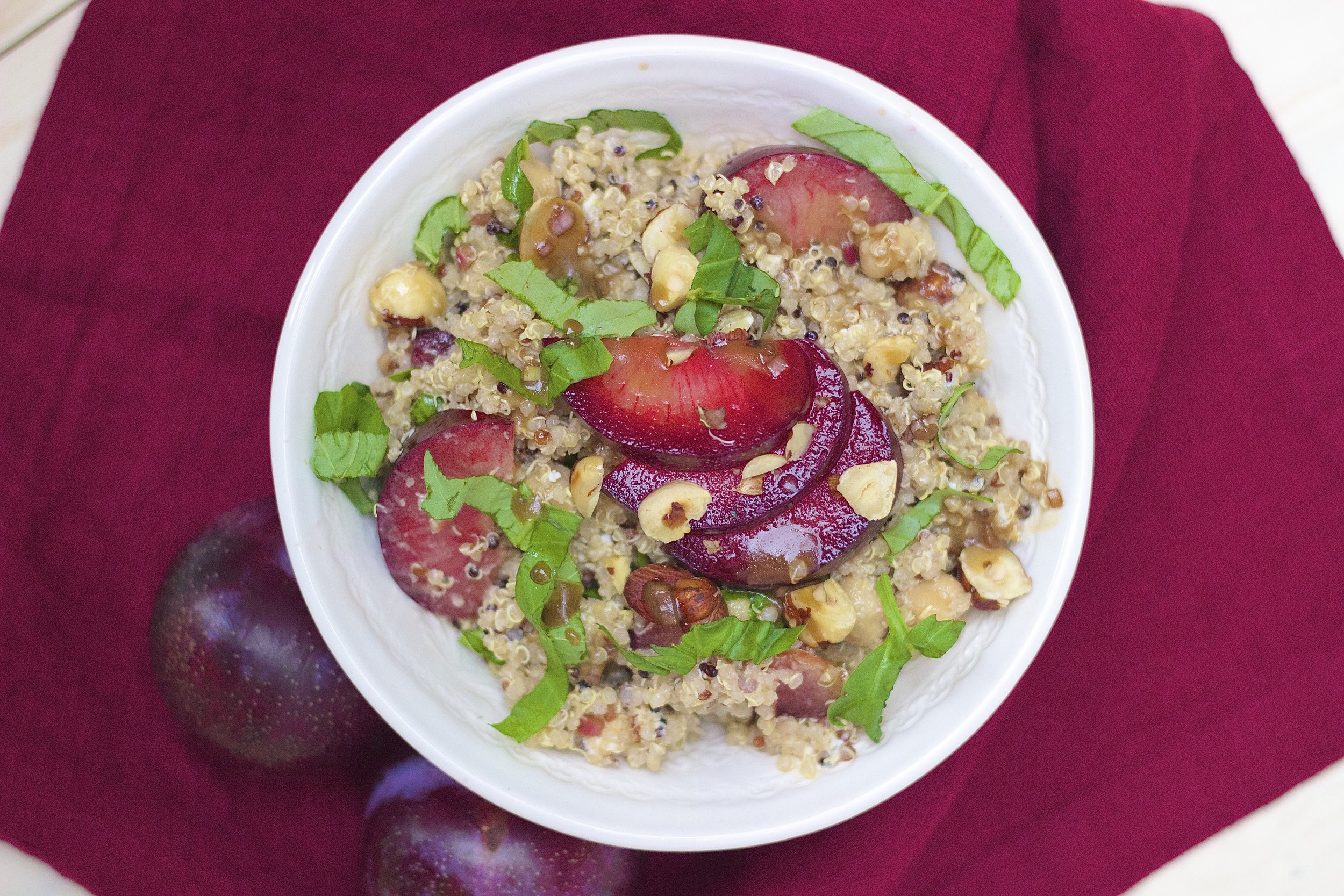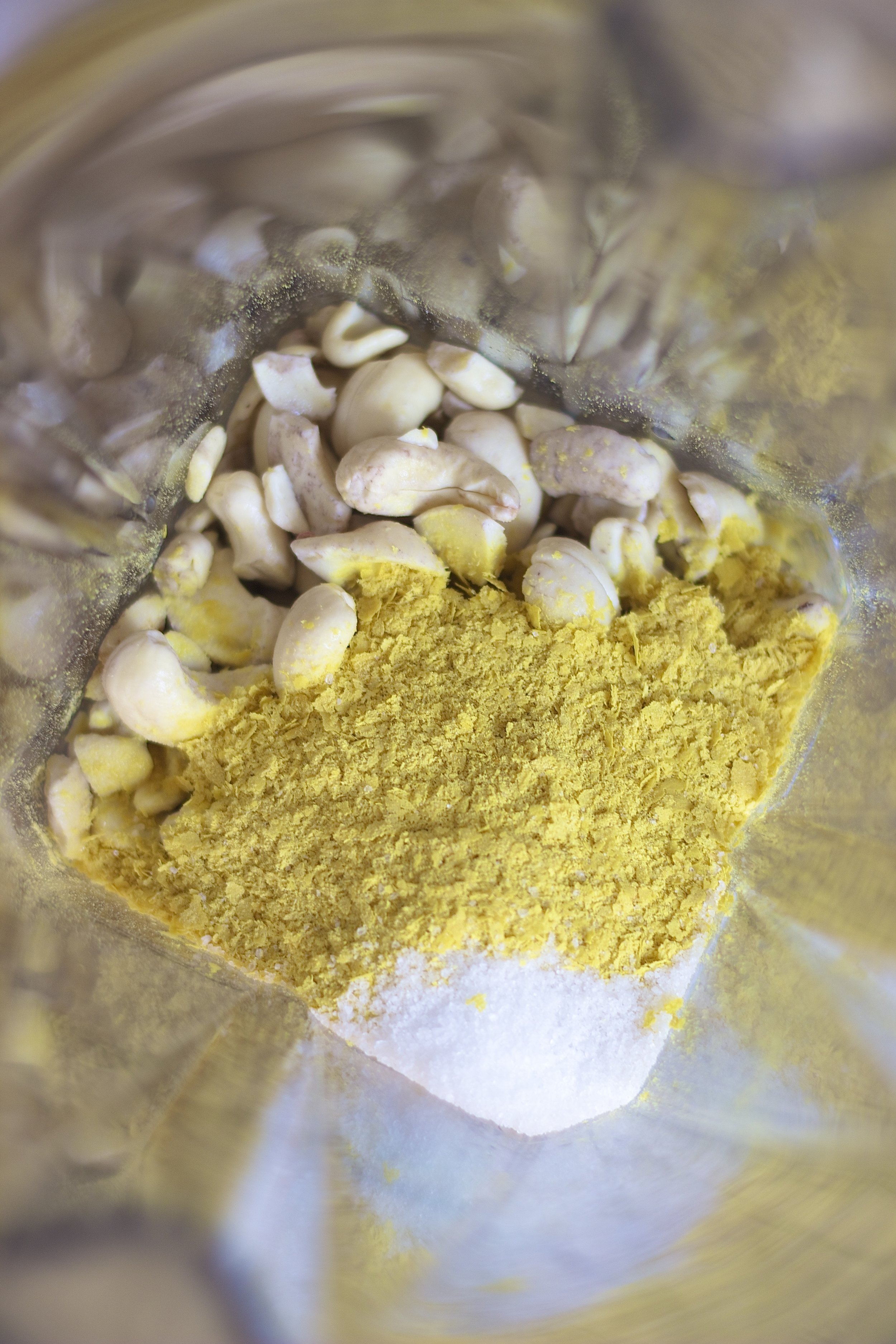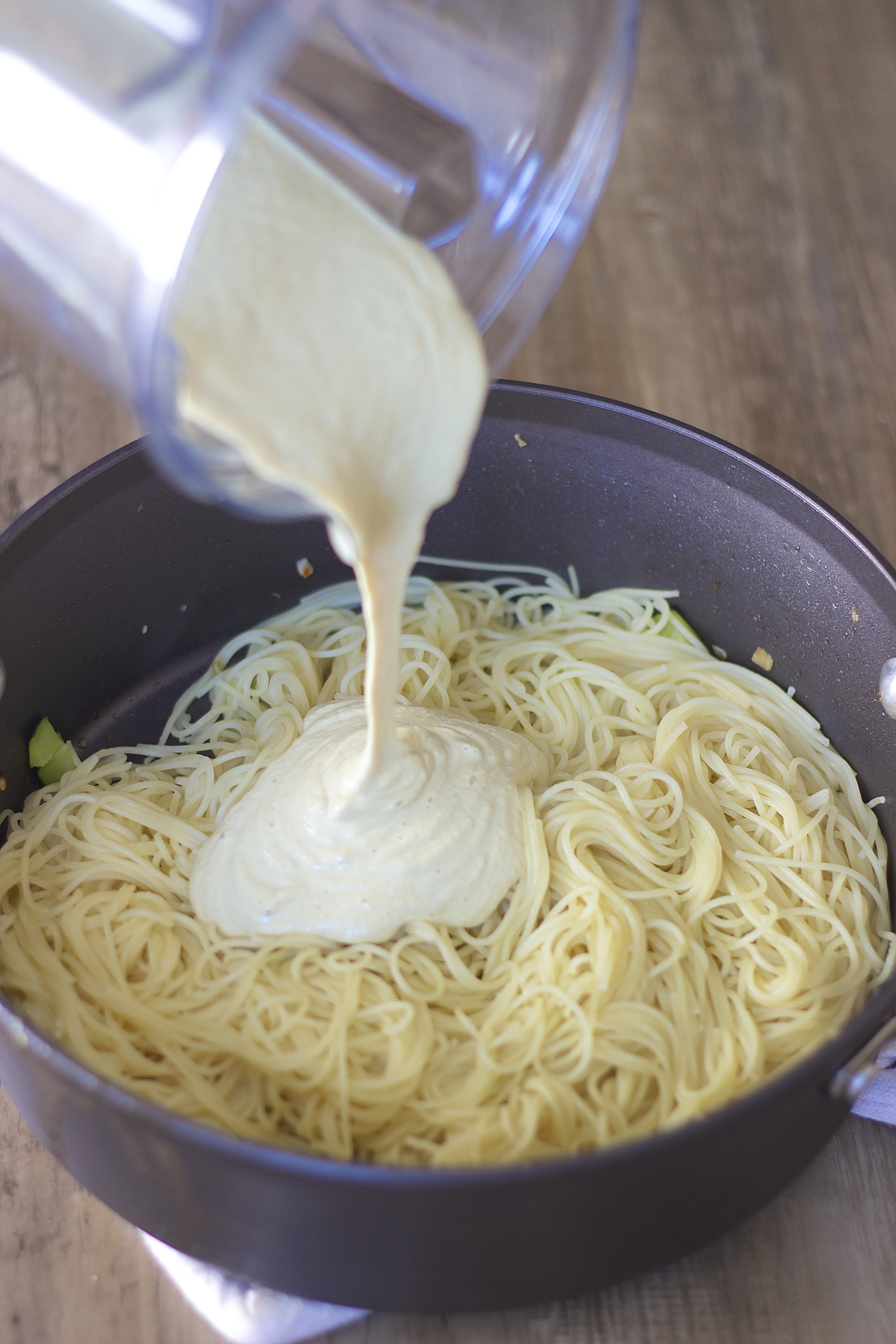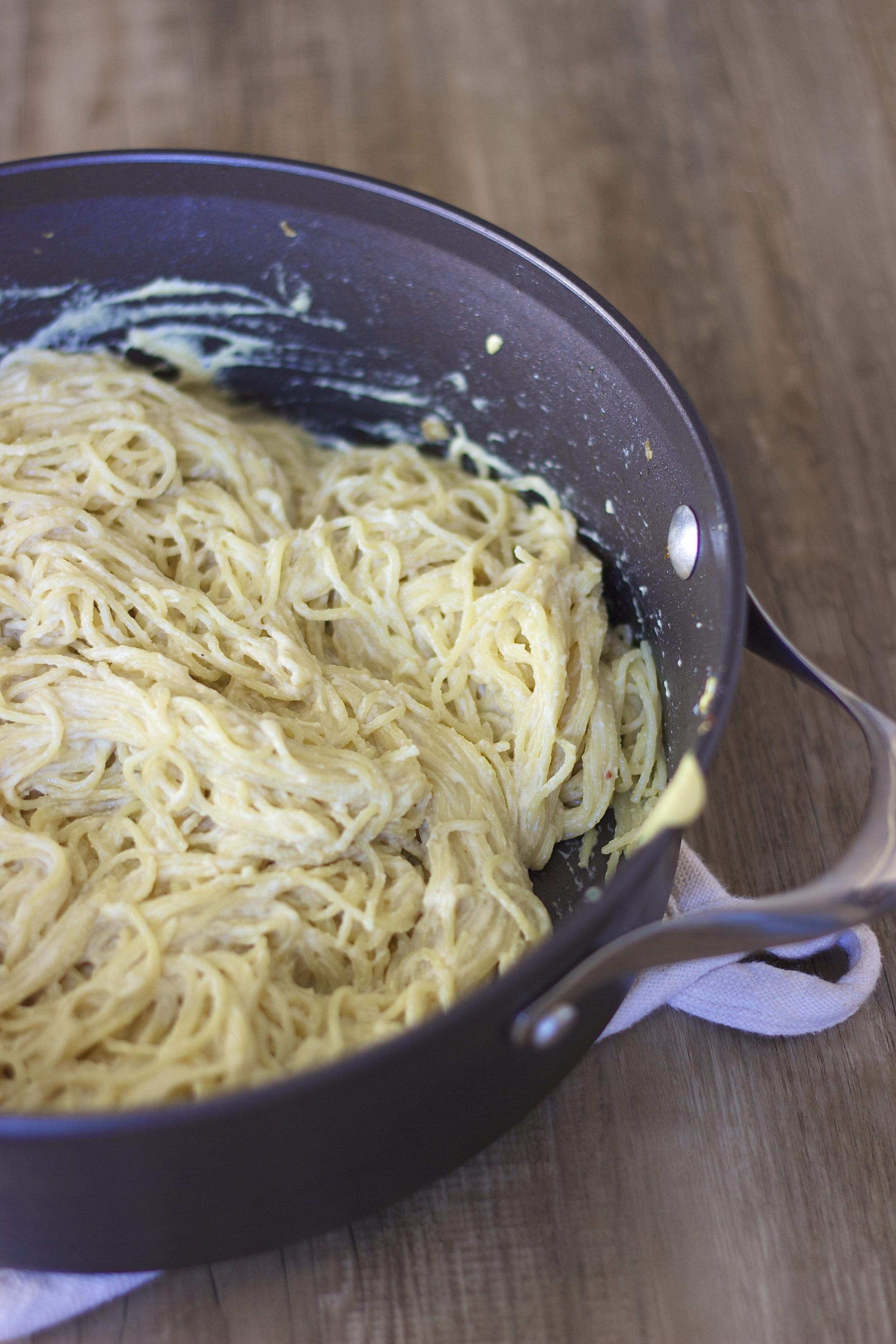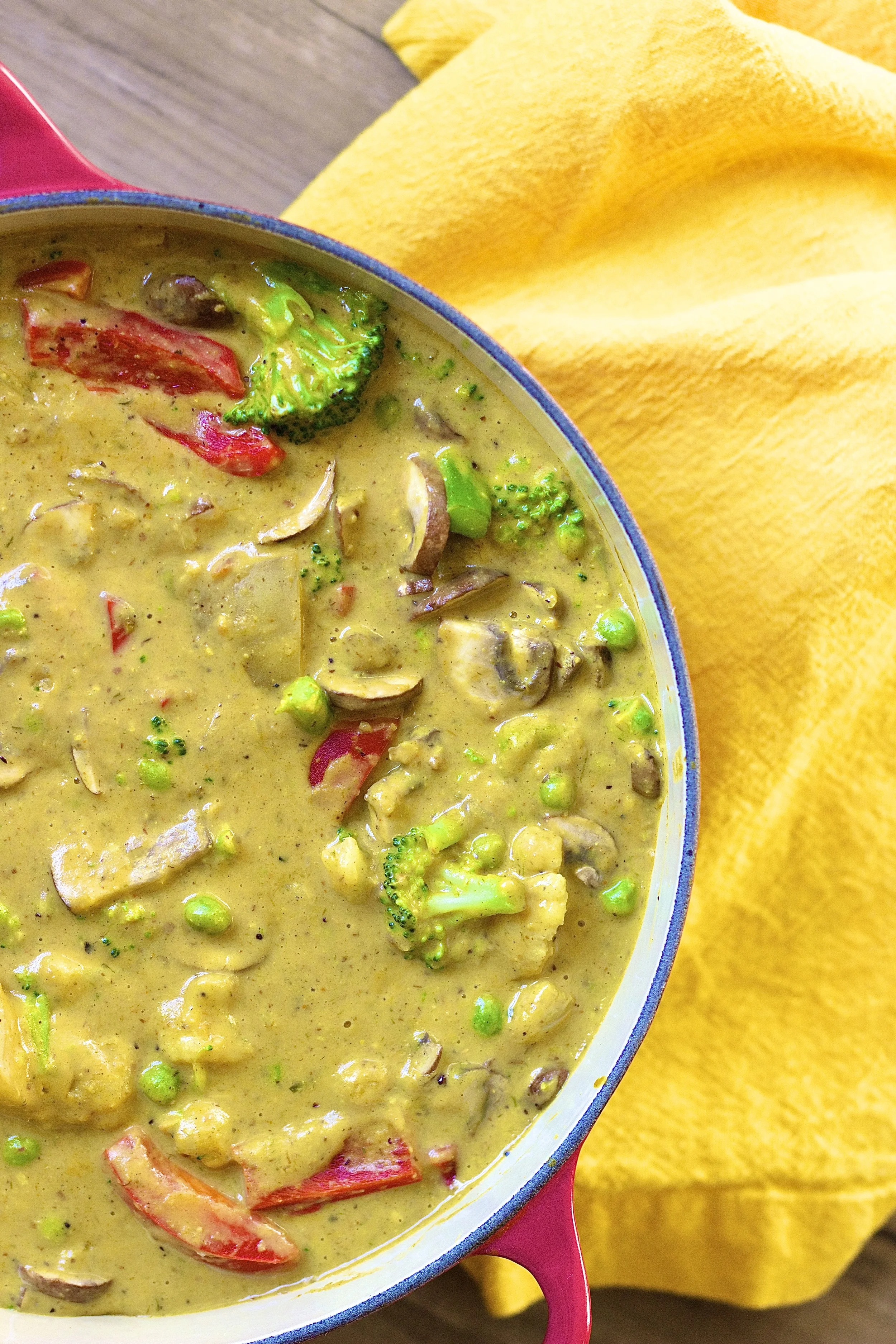Quinoa Pluot Bowls {gf}
I started grad school year two of five last week. It felt like I was going into battle with not enough time to prepare.
In an effort to hold onto some semblance of control in my life I started running 2-3 days a week. I've had a love hate relationship with running since childhood. My family is runners, I'm a runner, and I've turned to running in an addictive way many times throughout my life. I've started again after a couple years of hiatus and it feels SO GOOD. Something about working at a hospital all day, sitting with people through their pain and suffering, holding it together to offer them some bit of understanding and support leaves me feeling cooped up and emotionally drained. And when I run I let it all out, I sweat, I race to Kelly Clarkson and all the other female-power artists in my spotify library and it feels so good. Yes, the idea of burning some calories and loosing some of the first-year-of-grad-school weight sounds appealing but even if I don't loose a pound I know that running makes me feel good on the inside. Mentally it feels so therapeutic.
I always remember learning in teacher training years ago that after animals experience a stressful events they run and shake and move their bodies as a way of releasing that tension. Humans just hold it. For me running seems to release it all in a way nothing else does. This morning I listened to an episode of NPR's "On Being" called Running as a Spiritual Practice and it resonated so strongly with me. I've been listening to this song that repeats the lyrics "slow down" as I run, and even though my body is going fast I find that my mind is able to let go, slow down, and connect to all of the sensations of the present moment in a way that feels so healing.
I made this quinoa salad a couple weeks ago. It's my nod to the end of summer. Hearty whole grain salads have always filled me up and made me feel nourished in a way lettuce never quite could. This quinoa salad is no exception. The juicy sweet pluots offer the perfect nod to summer while the warm toasted hazelnuts seem to welcome fall. The basil keeps it fresh and the balsamic vinaigrette adds a zingy bite. It's really so good.
Feel free to skip on the goat cheese for a dairy free option, or substitute regular plums if you can't find pluots. This salad is intended to be simple and fuss-free.
Serves 2 as a main, generously
3/4 cup uncooked quinoa
1 1/2 cups water
1 small shallot, diced
4 tablespoons extra virgin olive oil
2 tablespoons balsamic vinegar
1/2 teaspoon honey (or agave/maply syrup if vegan)
pinch of salt & pepper
1/2 cup hazelnuts
1/4 cup crumbled goat cheese (optional)
3/4 cup cooked chickpeas (about half a can)
small handful basil
1-2 small pluots (or plums)
salt + pepper to taste
Place the water in a small saucepan over high heat, rinse the quinoa then add it to the water. Bring to a boil, cover, then reduce to a simmer. Cook for 15 minutes. Remove from heat but keep covered for 5 minutes. Remove the lid and fluff with a fork then toss with a generous amount of salt. Set aside to cool.
Make the dressing. Combine shallot, olive oil, balsamic, honey, salt and pepper in a small jar (I use a mason) and shake to combine.
In a small saucepan toast the hazelnuts over medium low heat for 3-5 minutes, tossing & watching regularly to ensure they don't burn. Once slightly browned and fragrant remove from heat. Thinly slice the pluots and the basil.
In a medium bowl combine the quinoa, hazelnuts, goat cheese, chickpeas, basil and dressing and toss. Gently stir in the pluots and serve.
Creamy Lemon Pasta with Summer Squash {vegan}
I may or may not have googled "how to survive a long dark winter" the other day. I normally love Fall, but after struggling through said long dark winter last year, coupled with a tough first year of grad school I am dreading busy schedules, early sunsets, and the closing of Chicago farmer's markets this Fall. Towards the beginning of August I totally panicked, thinking I had not taken advantage of summer the way I should have, and filled my calendar with summer music and film series in the parks, food festivals, and long family walks with pumpkin. We've been savoring this weather and biking all around the city for date nights in neighborhoods far from our own.
We've become religious about our Saturday morning farmer's market trips. I think I bought close to 10 pounds worth of peaches last week, blanched them, peeled them, sliced them, and then froze them. I've been adoring Chicago summer, humidity and all. I worship these warm summer nights and hours of day light. Seriously, the summer can't end, I haven't even made zucchini bread yet!
This pasta is light, summery, and creamy but dairy-free. Once you've soaked the cashews it comes together so easily and celebrates the simplicity and freshness of summer produce. We've been buying zucchini in bulk for what feels like pennies every week at the farmer's market and this veggie-heavy pasta is the perfect way to use them all. It also just so happens to be packed with plant-based protein (thank you nuts) and reheats great.
Serves 4
1 cup raw cashews, soaked 4-8 hours
3/4 cup water
1/4 cup nutritional yeast
1/2 teaspoon salt
8 oz angel hair pasta
2 tablespoons olive oil
4 garlic cloves, finely chopped
1/4 - 1/2 teaspoon red pepper flakes
2 pounds zucchini, diced
zest of 1 lemon
juice of 1/2 lemon
large handful of basil
1/4 cup shelled pistachios (optional)
salt + pepper to taste
Combine soaked cashews, water, nutritional yeast, and salt in a blender and blend until completely smooth and creamy. Set aside - note, this step can be done up to two days in advance.
Bring a pot of heavily salted water to a boil. Meanwhile, heat a large sauté pan over medium heat. Add olive oil, followed by the garlic, and red pepper flakes. Cook for 1-2 minutes until garlic has softened then add in the zucchini and toss to coat. Cook for 5-7 minutes, until the zucchini has softened and released some of its liquid. Remove from the pan and set aside.
Once the water is boiling add the pasta and cook until al dente (keeping in mind angel hair cooks very quickly). Reserve about half a cup of pasta water, then drain, and add the pasta to the sauté pan and top with the cashew sauce (you probably won't use all of it), and toss over low heat. If it looks to thick, use pasta water to thin. Then top with zucchini and toss. Add in lemon zest and juice, basil and pistachios. Add salt and pepper to taste. Serve and enjoy!
Vegetable Korma {vegan + gf}
Anyone who knows me knows I've had a long-time obsession with Indian food. As a practitioner of yoga and meditation, a student of ayurveda, a vegetarian, and a lover of all things Indian food, I sometimes think I was born into the wrong culture. Did you know an estimated 40% India's population are vegetarian? How cool is that?
When we lived in LA we went on a date night to our favorite indian restaurant and ordered the vegetarian special for two literally every single week. I've attempted cooking Indian food at home for years to no avail. It seems to always take hours, use hard-to-find ingredients, and never end up even half as good as in the restaurants. Unfortunately, Chicago's indian food scene is limited to a small neighborhood over an hour from us on the far north side so I've given Indian food at home another shot.
I've made this dish over and over and it's definitely restaurant-worthy with only a moderate amount of effort. Not only is it not filled with heavy cream (hello vegetable masala) but it's dairy and gluten free so everyone can enjoy.
Serves 6
For the Sauce:
3 tablespoons coconut oil
2 tablespoons fresh ginger, peeled & minced
1 teaspoon brown mustard seeds
1 small leek, finely chopped
3 tablespoons almond meal
2 tablespoons dried coconut
1/2 teaspoon cayenne pepper (see notes)
1 tablespoon korma powder (recipe below)
1/2 cup chickpea flour
3 cups vegetable stock
1 can full-fat coconut milk
1 tablespoon lemon juice
1 teaspoon tomato paste
1 large date, finely chopped
1 large handful cilantro
salt & pepper to taste
For the Vegetables:
8 onces yukon gold potatoes
6 ounces broccoli, chopped
6 ounces cauliflower, chopped
8 ounces mushrooms, thinly sliced
1 red bell pepper, sliced
1/2 cup frozen peas, defrosted
Notes: 1/2 teaspoon of cayenne makes for a rather mild to medium spiciness level. For no spice feel free to omit it altogether, for a hotter dish add more.
As with all Indian food, this dish tastes better on day 2 than day 1. Something about the spices blending together.
Heat a large saucepan over medium heat. Add coconut oil and heat until warm, followed by ginger and mustard seeds. Cook for about 4 minutes, stirring frequently. Stir in the leek and cook until it has softened, about 3 minutes.
Add the almond meal, coconut, cayenne, and korma powder, and cook until the coconut begins to brown, about 5 - 7 minutes, stirring frequently.
Sprinkle in half of the chickpea flour and stir until the mixture becomes a thick paste. Slowly pour in half of the stock, whisking constantly. Continue to whisk as you sprinkle in the remaining chickpea flour followed by the remaining stock. Continue to whisk for about 5 minutes until the mixture thickens to a gravy-like consistency.
Reduce the heat to low. Stir in the coconut milk, lemon juice, tomato paste, and date and heat until the mixture is warmed throughout. Using an immersion blender, blend the sauce until it is smooth and creamy (alternately, transfer the mixture to a blender). Add a generous amount of salt (to taste) and adjust spiciness level by adding more cayenne if needed. Leave the sauce on low while you prepare the vegetables.
Bring about 1 inch of water to a boil in a medium saucepan. Top with a steamer basket, making sure the water doesn't touch the basket. Meanwhile, chop the potatoes into bite size pieces, sprinkle with salt, and steam, covered, for 5-7 minutes or until tender. Transfer to the korma sauce. Repeat with broccoli and cauliflower which steam for about 2 minutes, mushrooms which steam for about 4 minutes, and bell pepper for about 2 minutes. Transfer the vegetables to the korma sauce once cooked and then stir in the peas.
Top the vegetable korma with chopped cilantro and serve with rice and/or naan bread.
For the Korma Powder:
1 tablespoon whole coriander seeds
1 tablespoon whole cumin seeds
1 tablespoon whole fennel seeds
1 tablespoon whole mustard seeds
1 tablespoon whole fenugreek seeds
1 tablespoon whole cardamon seeds
1 tablespoon poppy seeds
1 tablespoon ground cinnamon
1 tablespoon ground ginger
1 tablespoon ground turmeric
1 teaspoon ground cloves
Place all the ingredients in a spice grinder or spice mill and blend to combine. Alternately, grind the whole seeds into a power using a mortar and pestle then stir in the rest of the spices (I did it this way). Store in an airtight container.
Notes: This makes about 1/2 cup of powder which can be used to make this vegetable korma several times, but feel free to half the recipe as well.
